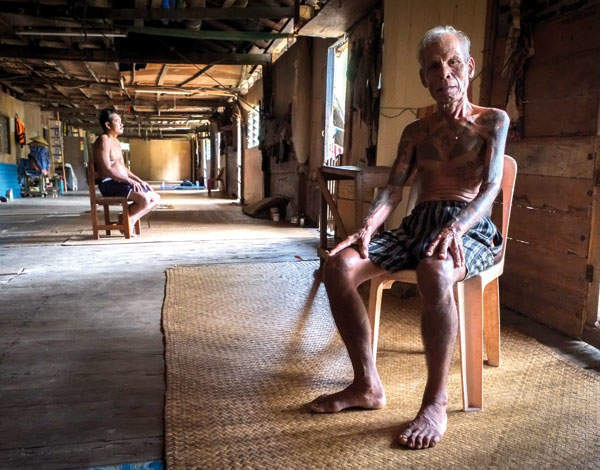

THE JUNGLE BROOKE
In the small village of Sheepstor on Dartmoor at St Leonard’s church, there are three men buried side by side: Sir James, Sir Charles Anthony and Sir Charles Vyner Brooke, the White Rajahs of the state of Sarawak, which is now part of Malaysia, on the island of Borneo. What was so fascinating about these men that prompted Joseph Conrad, Rudyard Kipling and George MacDonald Fraser to weave them into their books?
James Brooke (pictured below) was born in India in April 1803, son of a judge in the colonial service, and spent most of his childhood there. When he reached the age of twelve he was sent to England for his schooling, only to play truant frequently. Joining the army seemed to be the perfect vocation for him, but he was seriously wounded during the
First Anglo-Burmese war in 1825. He resigned and bought a 142-ton schooner, The Royalist, with a substantial inheritance. Now captain of his own private warship, he set sail for the city of Sarawak, today known as Kuching, hoping but perhaps little realising how his journey would change his fate, and Sarawak’s too.
Read more on travel from Spear’s
James arrived in the middle of a full-scale uprising by the native Bidayuh and Iban against the Sultan of Brunei. Brooke helped the Sultan’s local leader defeat the rebellion and in gratitude the Sultan awarded him the governorship of the state of Sarawak, along with the title Rajah. Brooke established his rule, codifying laws, reforming the administration and occasionally fighting pirates.

By the time his nephew Charles succeeded him 24 years later, James had become a Knight Commander of the Order of the Bath and British consul-general in Borneo and had received the freedom of the City of London. It is little wonder Errol Flynn was so eager to play him in an (unmade) Warner Bros production.
Stepping off my Malaysia Airlines flight wasn’t as exciting as disembarking from the victorious Royalist must have been, but the view of Kuching on the descent was no less inspiring. My guide Rose expertly brought me up to speed on the political landscape. ‘Sarawak has about 26 ethnic groups, so even being part of Malaysia since 1963 hasn’t changed any of our customs or heritage,’ she told me.
‘Are you Malaysian?’
‘Malaysian by nationality but Sarawakian by identity. We have Bidayuh, Ibans, Melanus and Orang Ulu tribes.’
About 60km outside Kuching, we pulled up at the Annah Rais longhouses — the traditional houses of the Iban. These extraordinary structures, made of bamboo, stand on stilts at the edge of the jungle. Families live together in one common room and during the day sit outside making clothes or other handicrafts they can sell in town.
A few played musical instruments, practising for the annual Rainforest World Music Festival, which has given the region a huge tourism boost.
‘How did the Bidayuh regard Sir James?’
‘Oh they felt he had great semangat. Once he visited a tribe and was seized by a group of old women. They pulled off his shoes and started to wash his feet. This water was used to fertilise the fields.’
I looked around for my own entourage, but no one was the least bit interested in my semangat.
‘Semangat is the living principle in all beings, and in James it was greater than others. People didn’t fear or hate him, but revered his leadership and courage.’
Sensitive nature
Sarawak is a photographer’s dream. For twenty years wardens at the Semenggoh nature reserve have been looking after young orangutans, orphaned as a result of the dreadful palm oil business or rescued from captivity. The national parks of Bako, Batang Ai or Gunung Gading are also excellent places to see orangutans in the wild.
The Semenggoh orangutans tell a sad story which people are starting to understand, but in a competitive economy can the government put a stop to deforestation? Who now stands for Sarawak?
As I was kayaking downstream from the upper reaches of the Sungai Sarawak Kiri, on the Borneo highlands, I realised that Sarawak’s natural beauty makes such cares all the more important. For a few hours my guide and I drifted through the jungle past reclining lizards (no crocodiles here) down the river’s course, carved through limestone mountains. Aside from the wind rustling the trees and the birds calling out to alert one another to our presence, there was nothing else.

And then, without warning, the heavens opened and warm rain hurtled down on us, drenching us through. We took shelter in a cave while it deluged for a few minutes and then, as if nothing had happened, stopped. Back came the birdsong and the rat-tat-tatting on the trees.Swapping kayak for dinghy, we motored out into shallow sea at the coastal area of Santubong. I strained my eyes against the setting sun to see a crocodile or turtle. A flash of grey passed by the boat.
‘The Irrawaddy dolphin,’ Rose said. ‘You are lucky — you don’t see them often.’
Three more surfaced and hovered for a moment while I got my camera snapping, then were gone.
I was worried that going back to Kuching town would disrupt my idyll nurtured in nature’s embrace. The toot-toots of scooters in the middle of Kuching’s old town; Chinatown; hawkers and peddlers crisscrossing the small road; Chinese restaurants bizarrely juxtaposed with Sikh temples, mosques and large European buildings. All was noise, aural and visual.
In those European buildings the Brookes have certainly left their legacy, be it the imposing Astana (now residence of the governor of Sarawak), Fort Margherita, the Court House or colonial-baroque clock tower. These are no more incongruous than the Chinese shops selling regional fruit and veg.
Family business
Sir James Brooke had a better end than Carnehan or Dravot at the end of Kipling’s The Man Who Would Be King, for which he was the inspiration: he was neither crucified nor dropped into a gorge. Following no fewer than three strokes, Sir James died in 1868, leaving no legitimate children. He named one nephew his successor but later changed his choice to another and for good measure banished the first. Brooke’s descendants still travel to Sarawak, where they are warmly welcomed.
Brooke certainly captured the imagination of his generation back in England, and even of later generations too: Fraser put him in Flashman’s Lady in 1977. He had a timeless quality, a potency, which true leaders must have. The old ladies of the village felt it and in modern Kuching you can still feel it.
Gone are the Rajahs, but the people and their beliefs, the jungle, the orangutans in the trees and the dolphins in the sea — they are Sarawak’s semangat.
sarawaktourism.com, suntravelborneo.com
END OF AN EMPIRE
– Sir James Brooke’s nephew, Sir Charles Anthony Johnson Brooke, succeeded him in 1868 and ruled until his death in 1917.
– Charles Anthony’s son, Charles Vyner, became the third and final White Rajah. He secretly ceded the territory to Britain in 1946.
– It thus became part of the Malayan Union, which achieved full independence as Malaysia in 1963.






